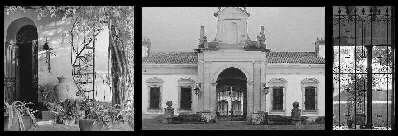
Fazendas Brasil - historic coffee plantation estates, Pariba Valley
colonial architecture plantations of the coffee circle
with links to historic estates for sale and fazenda resorts
Historische Kolonialstil Landgüter / Kaffee Plantagen, Paraiba, Brasilien
Dear visitors, I run this website because I am an afficionado of historic estates and to offer as realtor farmland and historic estates (below left), In a blog manner I on and off add a bit, I am not afiliated to any of the tourist ventures mentioned below.
left : Johann Georg Grimm (1881), Fazenda Retiro ( view here source, copyright )
right : Fazenda Grataú( view here source, copyright )
Peer Voss (impressum at bottom)

(the real thing)
historic estates for sale
![]()
Fazenda of the coffee circle, today a 350 hectare cattle ranch, Rio Province
![]()
Fazenda converted to an upmarket rural inn, on 305 hectare
and a bit further south :
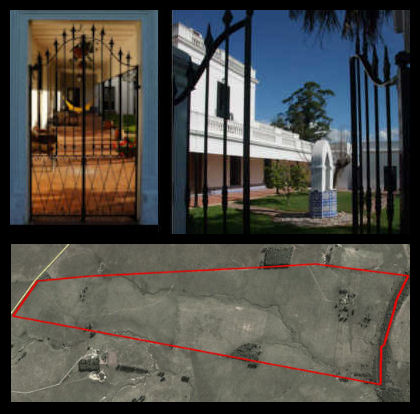
fsbo1) Historic Estate for sale :
167 hectare Estancia in Uruguay
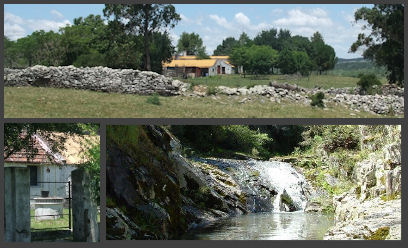
u289) 740 hectare rugged hill country cattle ranch Uruguay
Guest/Tourist Fazendas
resorts, inns in historic former coffee plantations
Fazenda Ponte Alte
Fazenda Sao Francisco
Fazenda Florenca
(to name a few of many)
books :
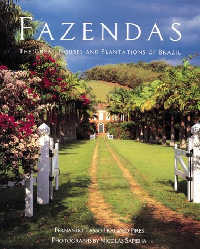
Fazendas
F. Tasso Fragoso Pires &
Nicolas Sapieha
Abbeville Press
ISBN 1-55859-876-6
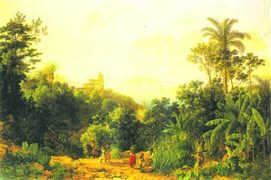
Tourists Revive Glory of Brazil's Old Coffee Farms
extracted from a Reuters article by Peter Blackburn
BARRA DO PIRAI, Brazil (Reuters) - Joao Carlos Streva, one of the last coffee farmers in the Rio Paraiba do Sul valley, now looks to tourism to help pay the bills.
Streva's Taquara "fazenda," a 2-1/2-hour drive south from Rio de Janeiro, is among some 20 farms in the Paraiba Valley that were restored in recent years to their 19th century glory when the area was the center of the world coffee industry.
Thousands of visitors now come annually to stay at and admire Taquara and other farms built with the fortunes made from exporting the prized beverage to Europe and United States.
They also relive Brazil's colorful coffee past by watching pageants of 19th century fazenda life, sleeping in slave quarters and viewing instruments of torture and rusting coffee grinders.
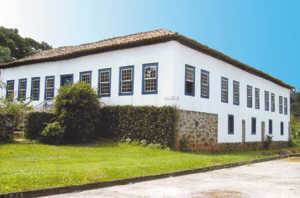 The coffee boom was shortlived. After the abolition of slavery in 1888, farmers moved south into the state of Sao Paulo where there was cheap Italian immigrant labor, fertile land and regular rain.
Rash farming in Paraiba had eroded the soil while destruction of the rain forest to plant coffee changed the climate, causing drought.
The coffee boom was shortlived. After the abolition of slavery in 1888, farmers moved south into the state of Sao Paulo where there was cheap Italian immigrant labor, fertile land and regular rain.
Rash farming in Paraiba had eroded the soil while destruction of the rain forest to plant coffee changed the climate, causing drought.
Taquara farm, named after the abundant bamboo in its fields, switched like many others to cattle and later to pig and chicken farming. But earnings were meager.
"Tourists help cover costs but my passion has always been coffee," said Streva, 59, surveying the coffee groves on the picturesque hills around the farm founded in the 1830s by his Portuguese ancestor, Comendador Joao Pereira da Silva.
Streva said that coffee was replanted at Taquara, near Barra do Pirai, when prices boomed in the mid-1970s after frost destroyed the Brazilian harvest. But due to surpluses and depressed markets, he is now converting to organic coffee which offers better profits.
Streva, whose family has farmed at Taquara for five generations, said that pigs provide 80 percent of farm revenue.
Pig slurry spread as fertilizer will be an important element in making organic coffee viable, he added.
LUXURY IMPORTS
Streva's wife Ana Maria shows visitors around the imposing rustic farmhouse and slave quarters, little changed after nearly 200 years with 12-foot-high ceilings and thick stone walls filled with "pau-a-pique" (wood and clay).
"Although it wasn't a baron's farm, the coffee cups were imported from China, France and Britain," she said, adding that nearly everything was imported -- French furniture, glass chandeliers and mirrors in the ballroom.
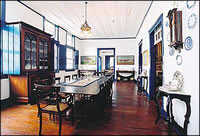 Through cracks in the original wooden floorboards, the slaves' area on the ground floor can be glimpsed. Coffee and homemade corn and guava cake are served within view of heavy leg and hand iron shackles -- grim reminders of the brutal punishment meted out to the African slaves.
Tourism is now injecting new life into many 19th century fazendas in the Vassoura, Valenca, Conservatoria coffee triangle in the Paraiba valley.
Tourist revenue covers maintenance costs at the Fazenda Sao Joao da Prosperidade, an early 19th century coffee farm that Magid Muiz and her engineer husband Luiz bought as a ruin 30 years ago.
"We've had 3,000 visitors so far this year," said Magid, describing Sao Joao as a rustic farmhouse.
Even so it has 15 bedrooms, six living rooms, a chapel and huge kitchen.
A major problem in the early 19th century was the farm's remote location -- a 10-day ride by mule train or horse and cart over the mountains to Rio de Janeiro, said Magid,
adding that the railway didn't reach nearby Barra do Pirai until 1864 when the local coffee industry coffee was already in decline.
Through cracks in the original wooden floorboards, the slaves' area on the ground floor can be glimpsed. Coffee and homemade corn and guava cake are served within view of heavy leg and hand iron shackles -- grim reminders of the brutal punishment meted out to the African slaves.
Tourism is now injecting new life into many 19th century fazendas in the Vassoura, Valenca, Conservatoria coffee triangle in the Paraiba valley.
Tourist revenue covers maintenance costs at the Fazenda Sao Joao da Prosperidade, an early 19th century coffee farm that Magid Muiz and her engineer husband Luiz bought as a ruin 30 years ago.
"We've had 3,000 visitors so far this year," said Magid, describing Sao Joao as a rustic farmhouse.
Even so it has 15 bedrooms, six living rooms, a chapel and huge kitchen.
A major problem in the early 19th century was the farm's remote location -- a 10-day ride by mule train or horse and cart over the mountains to Rio de Janeiro, said Magid,
adding that the railway didn't reach nearby Barra do Pirai until 1864 when the local coffee industry coffee was already in decline.
REGAL SPLENDOR
But wealthy coffee barons had already built palatial homes, such as the majestic Fazenda Ponte Alta near Barra do Pirai.
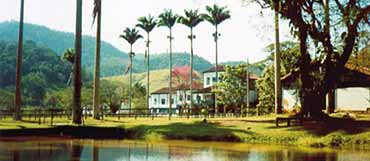 Built by the Baron Mambucaba in 1830, the vast farm where more than 200 slaves toiled stands in a tranquil valley behind vast stables and flanked by two rows of imperial palm trees.
A favorite weekend retreat of former Brazilian dictator Getulio Vargas, it welcomes mainly foreign visitors seeking the faded grandeur of Brazil's 19th century coffee boom and meals served with silverware in French neoclassical dining room.
European visitors, mainly French, are the most numerous further east at the Fazenda Sao Francisco, near Sao Jose do Barreiro. It claims to be the oldest coffee farm in the region and offers tourists a personalized welcome without television and other modern trappings.
"We treat visitors as house guests. Europeans are familiar with this concept. Brazilians still prefer privacy and hotel style en-suite bedrooms, " said Walton Ferreira Leite, a 62-year-old doctor, who with his dentist wife Eliana has gradually restored the 1813 fazenda over the past 20 years.
"Lots of friends used to visit us. But when there was a financial crisis six years ago we started taking paying guests. We eat at the same table and the idea is to mix," Walton said.
Built by the Baron Mambucaba in 1830, the vast farm where more than 200 slaves toiled stands in a tranquil valley behind vast stables and flanked by two rows of imperial palm trees.
A favorite weekend retreat of former Brazilian dictator Getulio Vargas, it welcomes mainly foreign visitors seeking the faded grandeur of Brazil's 19th century coffee boom and meals served with silverware in French neoclassical dining room.
European visitors, mainly French, are the most numerous further east at the Fazenda Sao Francisco, near Sao Jose do Barreiro. It claims to be the oldest coffee farm in the region and offers tourists a personalized welcome without television and other modern trappings.
"We treat visitors as house guests. Europeans are familiar with this concept. Brazilians still prefer privacy and hotel style en-suite bedrooms, " said Walton Ferreira Leite, a 62-year-old doctor, who with his dentist wife Eliana has gradually restored the 1813 fazenda over the past 20 years.
"Lots of friends used to visit us. But when there was a financial crisis six years ago we started taking paying guests. We eat at the same table and the idea is to mix," Walton said.
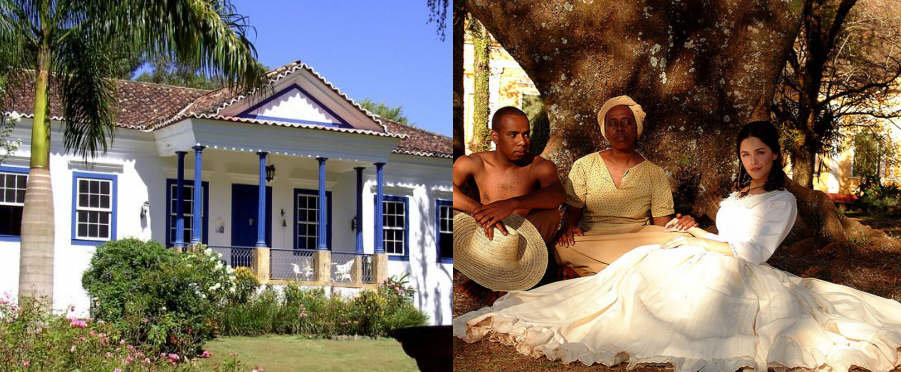
lending glamour to telenovela Escrava Isaura : Fazenda Florenza
Story by Pamela A. Campbell
The coffee barons probably never dreamed their plantations would see glory days again, but this time it's a work of art - preserving the rich, colorful history that transcended throughout the land, leaving a remarkable legacy for the people of Brazil and their visitors. Now all it takes is a bit of a drive to the Vale do Paraiba (Paraiba Valley) to find the 18 fazendas (coffee plantations) that have been developed as hotels, eager to entertain and enlighten guests about the days of the coffee bourgeoisie in 18th Century Brazil.
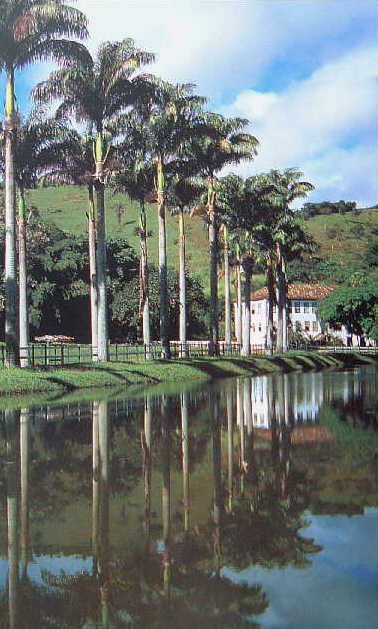 Some 170 years later, the giant palm trees still gently sway in the wind, the horse stable still exists and it's a long walk up to the grand old house.
Thanks to Evelyn Pascoli (who inherited Ponte Alta from her aunt Nellie) we can still witness the existence of the coffee plantation, restored as closely as possible to its original state.
Committed to keeping history alive, Evelyn is one of the founders of PRESERVALE - Institute of Preservation and Development of the Paraiba Valley.
Some 170 years later, the giant palm trees still gently sway in the wind, the horse stable still exists and it's a long walk up to the grand old house.
Thanks to Evelyn Pascoli (who inherited Ponte Alta from her aunt Nellie) we can still witness the existence of the coffee plantation, restored as closely as possible to its original state.
Committed to keeping history alive, Evelyn is one of the founders of PRESERVALE - Institute of Preservation and Development of the Paraiba Valley.
The three-storied home has retained many 'originals' from Nellie Pascoli's collection. Nellie's strong desire to preserve the plantation allows visitors to come face to face with history.
Besides guest rooms in the main house (with beautiful views), the slaves' quarters (senzala) were converted into guest rooms, with many period furnishings.
A chapel, complete with wooden pews and altar remain in excellent condition. Large windows allow the gentle breezes to waft indoors and permit an almost endless gaze of the surrounding estate.
A small hospital for the slaves was built alongside the quarters to facilitate healthy births and ensure a strong and steady workforce.
Visitors may never forget the haunting memories of the exhibits at the slave museum. Coffee beans, containers, implements, and hand and foot shackles are displayed in the small room.
A copy of the framed proclamation of the abolition of slavery is hung on the wall for all to read and remember.
Prepare to relax by just walking the grounds, seeing the water wheels, relaxing in a hammock on the porch or enjoying the panoramic views from the many windows.
You'll probably be as fascinated as I was with the mysterious Bombax, a pretty pink flower that covers the tree with no leaves (leaves will grow after the flowering season).
There are lots of floral beauties in abundance on the estate (see photos).To relive history in a foreign land is a precious experience, especially when it is as recent as Brazil's.
History aside, guests can expect some of the finest hospitality and cuisine this region has to offer. We were treated to a fabulous luncheon that would be the envy of some of the finest restaurants in the country...
(extracted here)
Brazil's Fazendas
Brazil has become so closely identified with coffee that many people believe the plant originated there. What happened in Brazil exemplifies the benefits and hazards of relying heavily on one product. Coffee made modern Brazil, but at an enormous human and environmental cost.
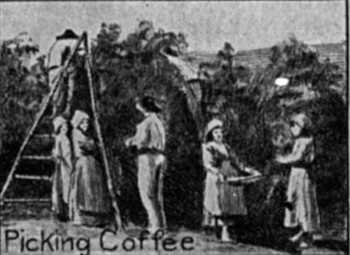 As sugar prices weakened in the 1820s, capital and labor migrated to the southeast in response to the coffee expansion in the region's Paraiba Valley.
While Francisco de Melo Palheta had brought seeds to Para in the northern tropics, coffee grew much better in the more moderate weather of the mountains near Rio de Janeiro,
where it had been introduced by a Belgian monk in 1774. The virgin soil, the famed terra roxa (red clay), had not been farmed because of a gold and diamond mining boom of the 18th century.
Now that the precious minerals were depleted, the mules that had once carted gold could transport beans down already-developed tracks to the sea, while the surviving mining slaves could switch to
coffee harvesting.
As coffee cultivation grew, so did slave imports to Rio, rising from 26,254 in 1825 to 43,555 in 1828. By this time, well over a million slaves labored in Brazil,
comprising nearly a third of the country's population.
As sugar prices weakened in the 1820s, capital and labor migrated to the southeast in response to the coffee expansion in the region's Paraiba Valley.
While Francisco de Melo Palheta had brought seeds to Para in the northern tropics, coffee grew much better in the more moderate weather of the mountains near Rio de Janeiro,
where it had been introduced by a Belgian monk in 1774. The virgin soil, the famed terra roxa (red clay), had not been farmed because of a gold and diamond mining boom of the 18th century.
Now that the precious minerals were depleted, the mules that had once carted gold could transport beans down already-developed tracks to the sea, while the surviving mining slaves could switch to
coffee harvesting.
As coffee cultivation grew, so did slave imports to Rio, rising from 26,254 in 1825 to 43,555 in 1828. By this time, well over a million slaves labored in Brazil,
comprising nearly a third of the country's population.
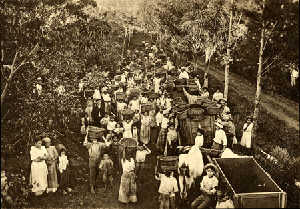 ....A system of huge plantations, known as latifundia, promoted a way of life reminiscent of the slave plantations of the Old South in the United States, and coffee growers
became some of the wealthiest men in Brazil.
....A system of huge plantations, known as latifundia, promoted a way of life reminiscent of the slave plantations of the Old South in the United States, and coffee growers
became some of the wealthiest men in Brazil.
In 1857, American clergyman J. C. Fletcher wrote of his visit to the 64 square mile coffee fazenda of Commendador Silva Pinto in Minas Gerais. "He lives in true baronial style,"
Fletcher commented appreciatively. In the huge dining room, three servants came, bearing "a massive silver bowl a foot and a half in diameter."
Later, he listened to fifteen slave musicians playing an overture to an opera, after which the black choir sang a Latin mass.
By the end of the 19th century, the coffee boom in the Paraiba Valley was over, mainly due to over-exploiting and thus degrading the soil.
